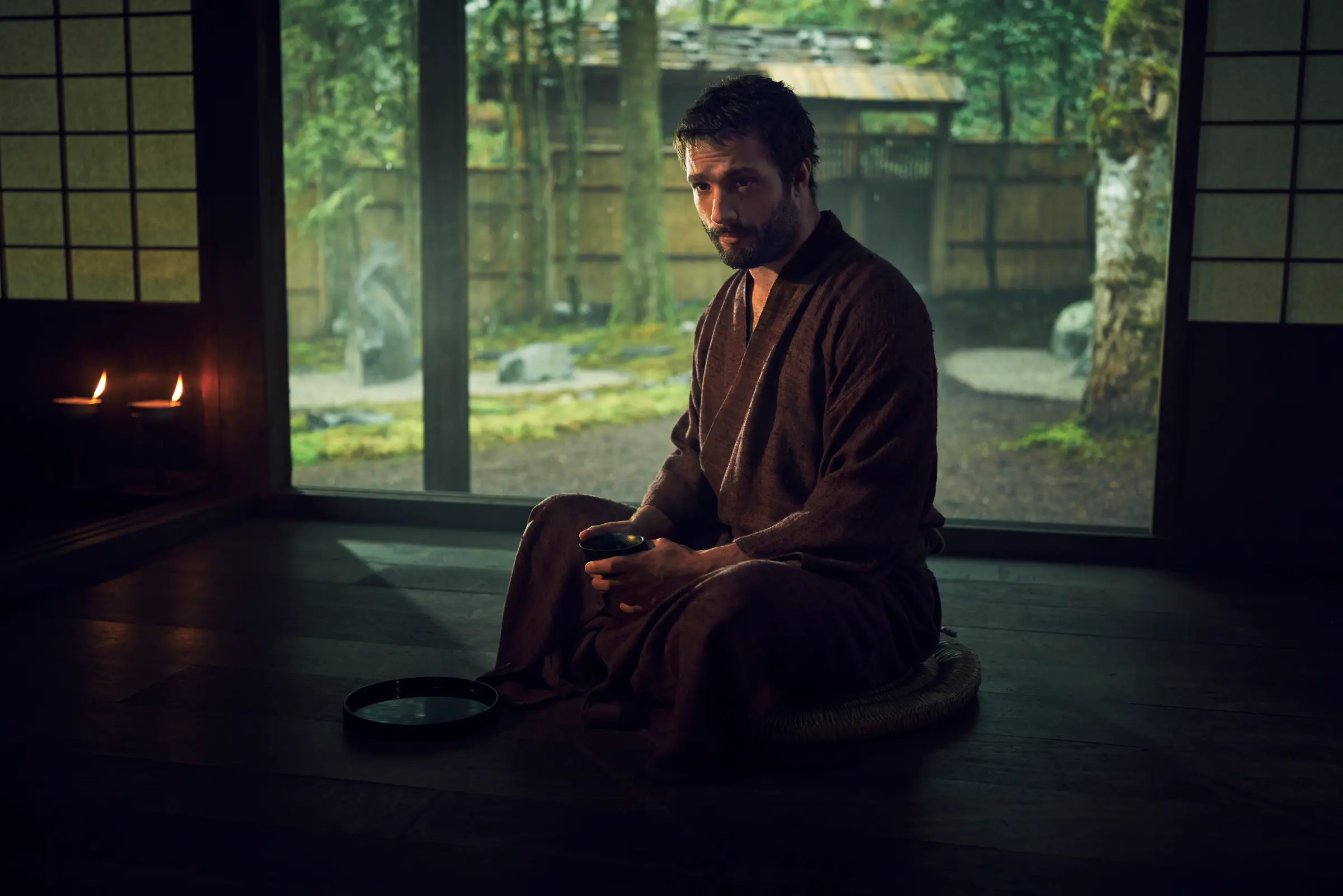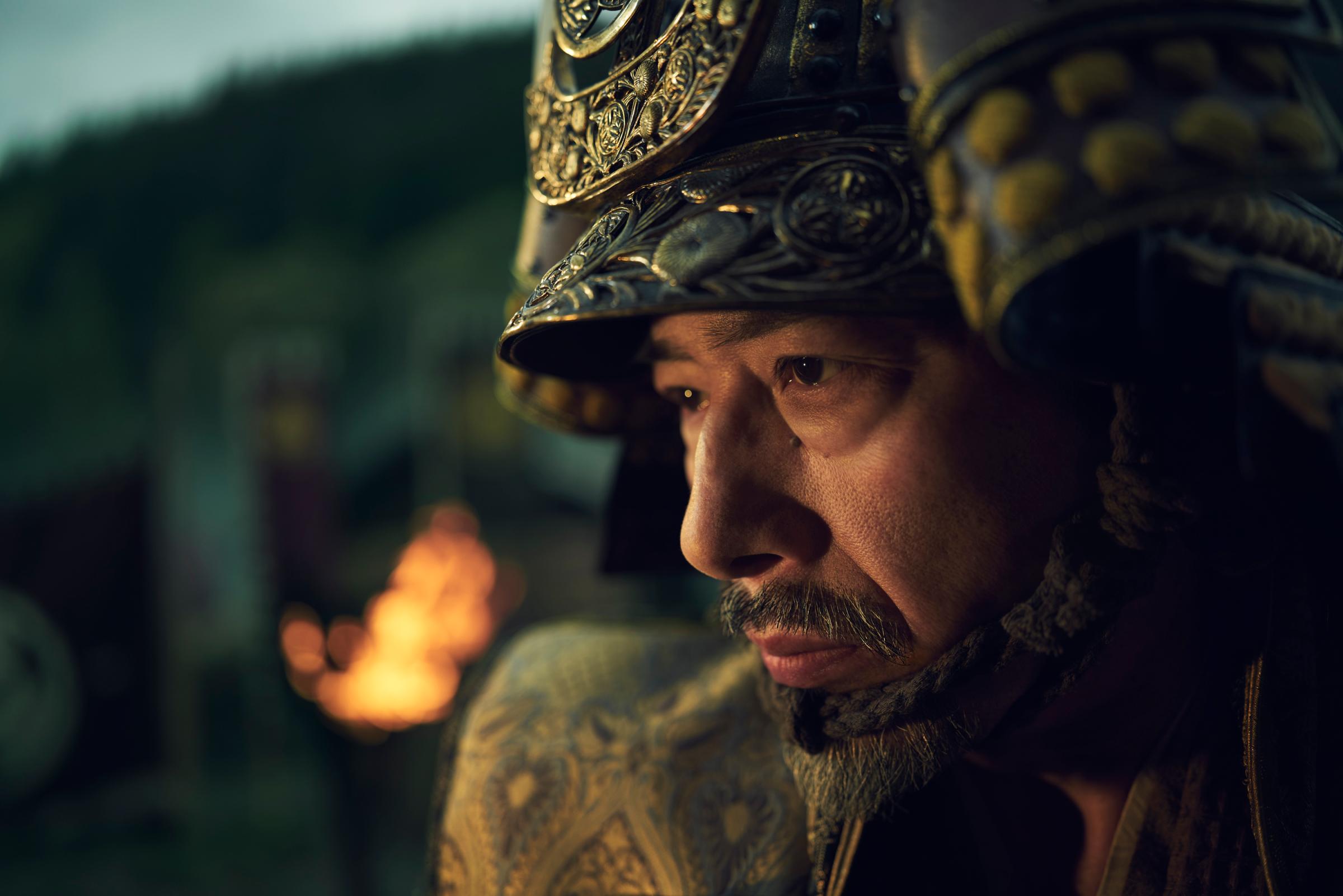Warning: This post contains spoilers for the first two episodes of FX's Shōgun.
When the Dutch warship Erasmus is wrecked off the coast of turn-of-the-17th-century feudal Japan in the opening scene of FX's new Shōgun miniseries, it sets in motion a sweeping saga of clashing cultures, political intrigue, and forbidden romance that also serves as a fictionalized account of one of the most momentous periods in Japanese history.
Co-created by husband-and-wife duo Justin Marks (Top Gun: Maverick) and Rachel Kondo, the historical epic—the first two installments of which are now streaming on Hulu—opens with a series of title cards that lay out the stakes at hand: "The year is 1600. For decades, Portuguese Catholics have richly profited from trade in Japan. They have kept its whereabouts hidden from their sworn enemies—the European Protestants. In Osaka, the reigning Taikō has died, leaving behind an heir too young to rule. Five warrior lords are now trapped in a bitter struggle. All of them seek the title that would make their power absolute...Shōgun."
Following its two-episode premiere on Feb. 27, a new episode of the 10-episode limited series will debut every subsequent Tuesday, with the finale set to air April 23. The show will cover the entirety of the best-selling 1975 James Clavell novel on which it's based.
Read More: FX’s Shōgun Isn’t a Remake—It’s a Revelation
What is Shōgun about?
Like the book, FX's Shōgun begins with Erasmus' English pilot (i.e., navigator) John Blackthorne (played by Cosmo Jarvis) and his surviving crew members being brought ashore in the fictional fishing village of Anjiro. There, they are taken prisoner by local samurai Kasigi Omi (Hiroto Kanai) and must await the arrival of Omi's uncle, Kasigi Yabushige (Tadanobu Asano), the daimyo (i.e., feudal lord) who will decide their fate. Blackthorne, soon rechristened Anjin (the Japanese word for pilot), is eventually transported to Osaka, where he becomes embroiled in the life-or-death power skirmish playing out between Lord Yoshi Toranaga (Hiroyuki Sanada, a producer on the series) and the other four members of the Council of Regents. Caught in the middle of Toranaga and Blackthorne's machinations is interpreter Lady Toda Mariko (Anna Sawai), a noblewoman who has converted to Christianity and is the last surviving member of a disgraced family line.

The narrative arcs of these three main players is what drives the show's plot and, according to Marks, underscores one of its most significant themes: "how we find control over our destiny in situations where we ultimately have to acknowledge how little control we have."
"All three of those characters start the story in one way or another as prisoners," Marks told Entertainment Weekly. "Toranaga is a political prisoner; Mariko is a prisoner of gender, faith, marriage, her past; and then Blackthorne is a literal prisoner when he shows up on these shores. But all of them then have three very different ways of navigating their plight and finding failure in some cases or empowerment in other cases."
The fates of this unlikely trio become increasingly entwined as the story unfolds against the backdrop of a looming civil war, taking viewers on a sprawling journey that both condenses and expands on Clavell's career-defining work.
How FX's series builds on James Clavell's novel
Originally published as a weighty 1,100-plus page tome comprised of nearly half a million words, Clavell's Shōgun had the potential to be dismissed as too lengthy of an undertaking for many readers. Instead, the novel rocketed up best-seller charts, remaining on the New York Times list for more than 30 weeks. In 1980, it was adapted into a five-part NBC miniseries starring Richard Chamberlain and Toshiro Mifune that drew 120 million viewers, the largest audience for a miniseries since ABC's massively successful Roots. By 1990, the book had sold over 15 million copies worldwide.
FX's series follows Clavell's narrative closely, often drawing directly on the author's original dialogue and capitalizing on the elements of the story that turned it into a megahit. It also avoids a major pitfall of the 1980 miniseries by offering subtitles for the characters speaking in Japanese rather than leaving their dialogue untranslated. This "opens up Shōgun’s world immensely," according to TIME TV critic Judy Berman.
"We get private conversations, backstories, access to the inner lives of scheming double agents and ambitious courtesans and sons impatient to prove themselves through combat," she writes. "The expanded perspective makes the series a true, immersive saga."

The show also does some rearranging and compressing of Clavell's timeline that enables it to offer further insight into its characters' motivations. In the premiere, a tense meeting between Toranaga and rival warlord Ishido (Takehiro Hira) that takes place in the book after Blackthorne arrives in Osaka instead happens while the pilot is still trapped in Anjiro. The confrontation leads to one of Toranaga's samurai attempting to interfere on his behalf and subsequently pledging to commit the act of ritual suicide known as seppuku to atone for dishonoring his lord. He also offers up his infant son as additional collateral for his misdeeds.
When Mariko shows up to both comfort and convince the boy's mother that she must relinquish her son, it results in a more impactful—and much earlier—introduction for her character than Clavell originally put forth in the book. It also succinctly lays much of the groundwork for her character's emotional turmoil.
"I know you feel the pull of death. I've felt it too. However, it's a mercy that you must reject," Mariko tells the young mother, alluding to her own family's disgrace. "If he's ordered you to live, then that is your purpose."
More Must-Reads From TIME
- The 100 Most Influential People of 2024
- Coco Gauff Is Playing for Herself Now
- Scenes From Pro-Palestinian Encampments Across U.S. Universities
- 6 Compliments That Land Every Time
- If You're Dating Right Now , You're Brave: Column
- The AI That Could Heal a Divided Internet
- Fallout Is a Brilliant Model for the Future of Video Game Adaptations
- Want Weekly Recs on What to Watch, Read, and More? Sign Up for Worth Your Time
Write to Megan McCluskey at megan.mccluskey@time.com